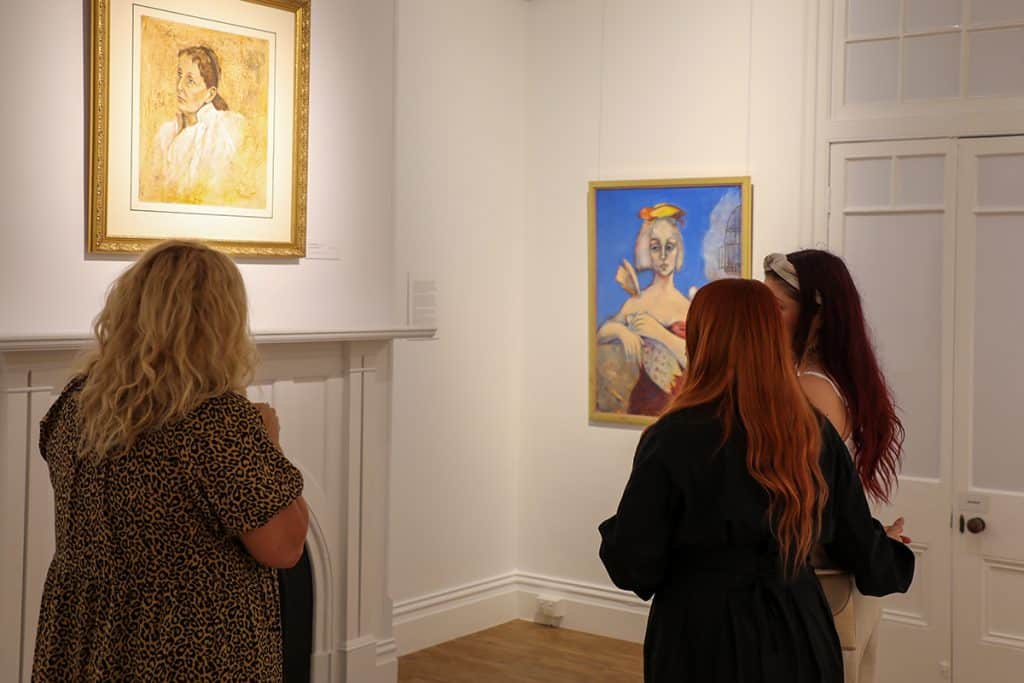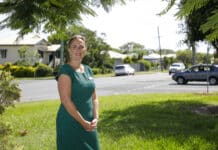
Female artists’ works will be on display for the pop-up Femminile art exhibition in celebration of International Women’s Day.
The exhibition explores female portraiture by artists from the Bundaberg Regional Art Galleries Collection, with some additional pieces on loan from significant private collections.
Local Jennifer McDuff’s artwork, Conversations on the Back Stairs, is one of the largest pieces in the pop-up exhibition.
Jennifer’s artwork depicts two females in deep conversation at their family home in Woodgate, and she said it was pleasing to know it was on show as part of the International Women’s Day exhibition.
“It’s two sisters – well my sister and myself actually – at our mother’s house in Woodgate,” she said.
“It’s truly wonderful to see the work of so many contemporaries in this exhibition.
“I believe its lovely to see so many works from female artists in the one exhibition.”
The common domestic scenario in Conversations on the Back Stairs is reflective of households across Australia, and is portrayed by Jennifer’s layering of inks, gouache and sewing patterns.
This work was created by Jennifer during an artist in residency in 1989, where the spaciousness of a loaned studio enabled her to work on a scale that was not practical in her home studio space.
Conversations on the Back Stairs is part of Bundaberg Regional Art Galleries Collection and was donated by local Doctor Cora Zyp in 2011.
A change for female artist came in the 1970s
The artwork Black and White Dance Sequence by Indonesian-born artist Irene Kindness is the cornerstone artwork in Femminile as it represents the 1970s.
This was a decade synonymous with the recognition of female artists within Australia and the realisation of gender equity milestones for Australian women.
Prior to the 1970s, very few women were appointed as trustees of state and national galleries, and the first female director of the National Gallery of Australia, Betty Churcher AO, was not appointed until 1990.
There was also an absence of women artists represented in educational curriculums, and low enrolment of women in tertiary arts programs.
According to the National Archives of Australia it was 1975 – International Women’s Year – that was the catalyst for change.
On the 8 March 1975, the first International Women’s Day rally was held in Australia.
Close to 5000 people attended the rally and campaigned for women’s rights such as: equal pay; equality in employment and education; safe contraception; the right for women to control their own bodies; and an end to violence against women and discrimination against same sex couples.
With the increasing recognition of female artists in Australia, came reviews of how women worked within the arts space compared to their male counterparts.
One of the significant differences noted, was the willingness of female artists to recognise their artistic peers, and indeed collaborate with them.
This was particularly so with the rise of Women’s Art Movements across Australia, that placed value on conversation, connectivity, and women-to-women relationships.
In the 1970s, the Bundaberg arts scene was influenced by a female led private gallery, Allamanda Gallery, that was instrumental in shaping the vibrancy of arts practice throughout the decade.
While incorporating both genders in its artist following, it was primarily the female artists of the time, such as Coralie Busby, Jo Williams, Jennifer McDuff, and later, Ann Grocott and Helene Grove, who built on their connectedness and provided inspiration and support to each other over the ensuing decades.
To view their artworks in the Femminile exhibition visit Bundaberg Regional Art Gallery before 19 March.
- Other news: New students get to know CQUniversity campus







